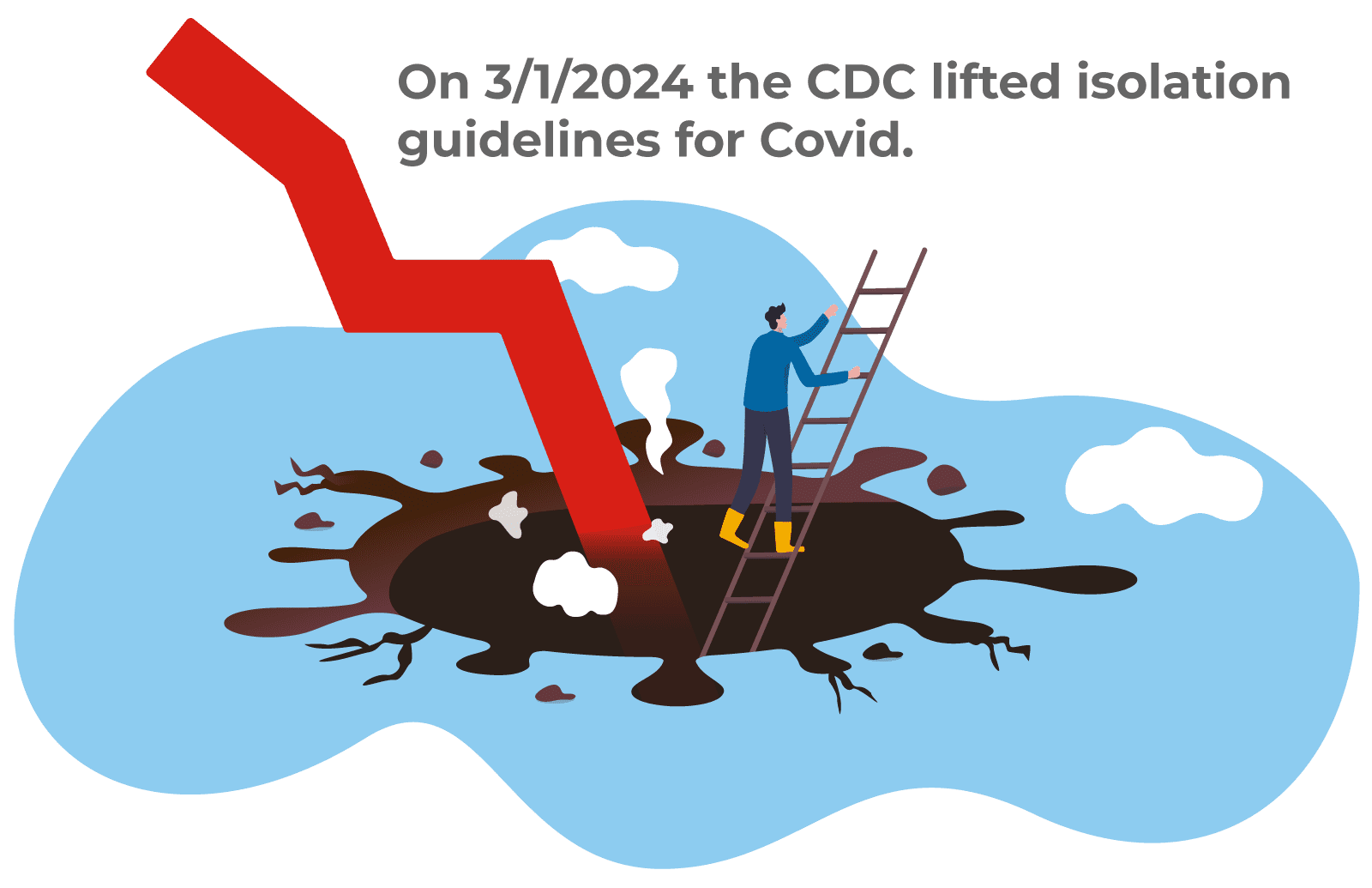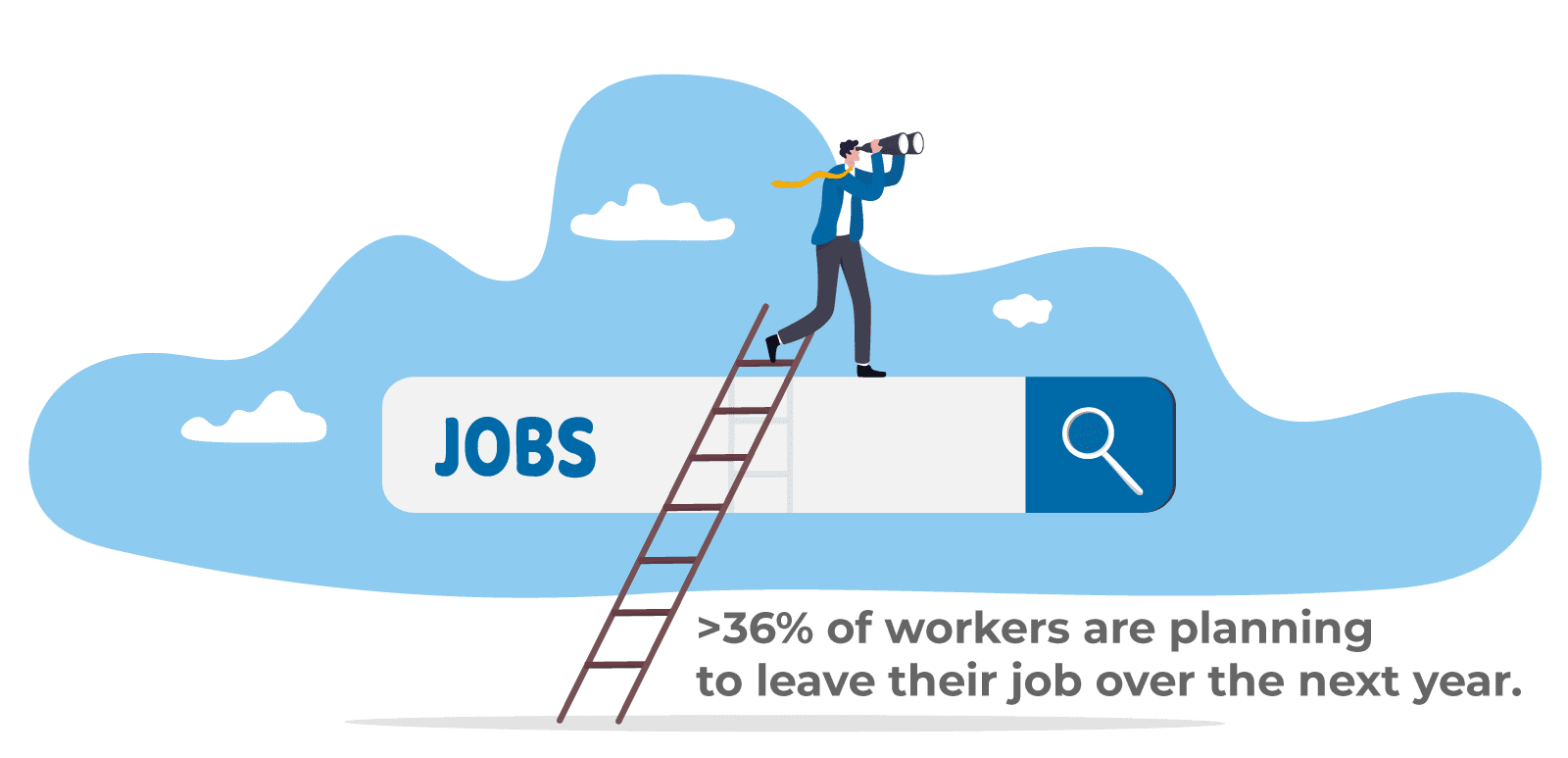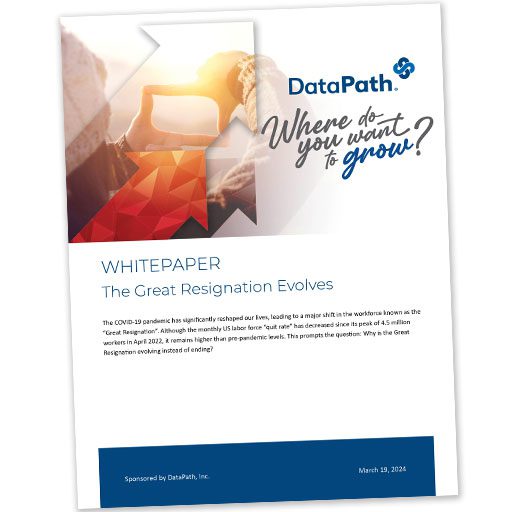The COVID-19 pandemic has significantly reshaped our lives, leading to a major shift in the workforce known as the “Great Resignation”. Although the monthly US labor force “quit rate” has decreased since its peak of 4.5 million workers in April 2022, it remains higher than pre-pandemic levels. This prompts the question: Why is the Great Resignation evolving instead of ending?
Impacts of the Pandemic Remain with Us

March 2024 marks the fourth anniversary of the U.S. declaration of a National Emergency in response to the spread of COVID-19. That National Emergency formally ended nearly a year ago, and public health officials have since lifted isolation guidelines for those who test positive for the coronavirus.
Yet, many direct and side effects of the pandemic still remain with us. Here are just a few examples:
- In October 2023, the Census Bureau estimated that 9.5% of the 134 million U.S. adults who had been diagnosed at any point with COVID-19 were still actively experiencing “long COVID,” or debilitating symptoms that continue indefinitely. That equates to 5.3% of all adults in America.
- Sociologists at Baylor University found that the pandemic has warped our perception of time, with the extent of disorientation affected by social, familial, physical, and work situations. Given the connection between altered time perception and mental well-being, the sense that time is not moving “normally” is expected to exacerbate mental health issues (notably stress, depression, anxiety, and feeling a loss of control) well into the future.
- The prevalence of remote work that began during pandemic lockdowns has influenced housing markets and rent dynamics. A study by the Federal Reserve Bank of San Francisco estimates that 60% of the substantial rise in housing prices since 2019 is attributable to the increase in remote working.
- Only 7% of paid workdays, on average, were worked remotely in 2019. By September 2023, that had jumped to 28%, with 14% of full-time employees working fully remote and 29% working hybrid.
However, perhaps the most readily measurable impact of the pandemic’s lingering effects on our society is its continuing influence on American attitudes toward work.
Pandemic-Era Influences
What is now known as the Great Resignation, also called the Great Reshuffling and the Great Reset, saw record numbers of employees quitting their jobs.
Over the three-year period from March 2020 through March 2023, approximately 131 million resignations took place in the U.S. labor market. This included more than 50 million in 2022 alone and an all-time monthly record of 4.5 million in April 2022.
As Americans endured lockdowns and social distancing, they reflected on many aspects of their lives. In terms of their relationships with work, millions decided that the jobs they had been working at no longer worked for them. Annoying traffic, time spent commuting, formal business attire, boring tasks, the inability to find reliable and affordable childcare – it all began to seem excessive. The overall quality of life became more important than the reasons that had previously motivated their job choice and loyalty.
Run a Google search and you will find countless articles and studies detailing the specific reasons workers quit their jobs in droves between 2020 and 2023. However, most of them relate in one way or another to six primary factors:Schedule and Location Flexibility
Seeking a better work-life balance, employees demanded remote work options and flexible schedules and weren’t afraid to change jobs to get them. A study by Flexjobs in 2022 found that among employees who had quit their jobs, 43% cited the lack of remote work options and 41% their inability to get a flexible schedule as major causes for their resignation.
Work-Life Balance and Burnout
High stress, often due to increased workloads, pushed many employees into pursuing jobs where these might be controlled more easily. In the FlexJobs study, nearly half (49%) identified the lack of a healthy work-life balance, and 42% specifically specified burnout, as significant contributors to their decision.
Compensation and Benefits
With a tight labor market on their side, employees who were experiencing discrepancies in pay and benefits (compared to industry standards or to others in their own company) were much less likely to continue tolerating these. Low salary (59%), lack of benefits or poor benefits (31%), and limited PTO or sick time (27%) were all cited by FlexJobs study respondents.
Health and Safety
In the wake of the pandemic, concerns about workplace safety and health protocols came to the forefront. FlexJob survey participants cited poor mental health support (22%), amount of travel required (19%), and concerns over COVID-19 vaccine requirements (17%) as among the factors influencing their decision to resign.
Company Culture and Management
Poorly managed organizational culture reinforced feelings of dissatisfaction and alienation among employees. In fact, toxic company culture (62%) was the top reason FlexJob study participants quit their jobs, followed closely by poor management (56%). The lack of diversity, equity, and inclusion initiatives was mentioned by 19% of respondents, and 18% did not feel connected to the company’s mission.
Career Growth
Limited opportunities for advancement and professional development were common reasons for a job or career change even before the pandemic. In the FlexJobs survey, more than a third (37%) of respondents who had quit during the Great Resignation cited limited advancement opportunities or career progression.
None of these influences on employee attitudes toward work has ceased, but all of them have changed somewhat. You might say that the root causes for The Great Resignation have not ended – rather, they have simply evolved.
Why did you quit your job? | Response |
|---|---|
Toxic Company Culture | 62% |
Low Salary | 59% |
Poor Management | 56% |
Lack of Healthy Work-Life Balance | 49% |
No Remote Work Options | 43% |
Burnout | 42% |
Not Allowing Flexible Schedules | 41% |
Limited Advancement/Career Progress | 37% |
Lack of Benefits/Poor Benefits | 31% |
Limited PTO or Sick Time | 27% |
Poor Mental Health Support | 22% |
Long-Term Job Stability | 21% |
Amount of Travel Required | 19% |
Not Having DEI Initiatives in Place | 19% |
Lack of Connection to Company Mission | 18% |
COVID-19 Vaccine Requirements | 17% |
FlexJobs, February-March 2022
Post-Pandemic Evolution
Although the number of American workers quitting their jobs each month has steadily declined since March 2023, it remains above pre-pandemic levels.
Between April 2023 and January 2024, for example, the U.S. labor market experienced an average of 3.4 million resignations each month, compared to a monthly average of 3.3 million in 2019 and 3.2 million in February 2020, the last full month before the National Emergency began.In their latest Human Workplace Index, released in March 2024, employee recognition company WorkHuman reported that while most employees surveyed (86.1%) are happy with their employer, more than 36% are still planning to leave their job over the next year.
Why are resignations remaining above pre-pandemic levels? Referring back to the six major factors influencing the Great Resignation, let’s look at some ways in which these factors have evolved, particularly over the past year.

Schedule and Location Flexibility
“Productivity paranoia” refers to the disconnect between managers and remote or hybrid employees regarding productivity levels. Research by Microsoft found that 85% of leaders have doubts about the productivity of employees they cannot see, compared to 87% of remote/hybrid workers who say they are just as productive.
This disconnect can lead to employees feeling less valued and less capable of doing their jobs. Nearly a fourth of the WorkHuman respondents feel they aren’t getting recognized as much as in-person workers. One in five fear increased layoffs resulting from management’s unrealistic productivity expectations.Work-Life Balance and Burnout
Productivity paranoia is also affecting work-life balance and burnout. More than a fourth of those in the WorkHuman study said that management paranoia over productivity makes them feel like they are never doing enough and that they shouldn’t take breaks.
In their 2023 Work in America Survey, the American Psychological Association (APA) found that only a third (35%) of respondents report that their workplace encourages breaks and only 40% say that time off is respected.
The latest challenge in human resources is “quick quitting” (not to be confused with quiet quitting and quiet firing). Quick quitting is when an employee resigns a job they have held for less than a year. Unlike those who quit during the Great Resignation (mostly front-line and blue-collar workers), quick quitters tend to come from the white-collar, management, and professional ranks. The root causes vary, but often these individuals find unexpected stressors or conflict at work (“job shift shock”), a lack of work-life balance in the new job, or a lack of access to resources.Compensation and Benefits
Pandemic-era inflation has led to growing interest among American workers in finding higher pay, even if they have to change jobs to get it.
Prior to the pandemic, the U.S. long-term average inflation rate had been about 3.2% a year. But what $100.00 would buy at the beginning of the National Emergency in March 2020 required $117.83 by the Emergency’s end in May 2023 due to increases in the Consumer Price Index over that three-year period.
In a survey conducted by Censuswide for LinkedIn in late 2023, the majority of workers from nearly every generation said they are considering moving on from their jobs in 2024.
Ranging from 48% of Boomers to 90% of Gen Z, these results represent significant increases from the same survey taken just one year earlier. According to a LinkedIn economist, the higher interest in job-switching is due in part to growing confidence in the U.S. economy.Do you plan to change jobs over the next year? | 2024 | 2023 |
|---|---|---|
Generation Z (born (1997-2012) | 90% | 72% |
Millennials (born 1981-1996) | 92% | 66% |
Generation X (born 1965-1980) | 83% | 55% |
Baby Boomers (born 1946-1964) | 48% | 30% |
Censuswide for LinkedIn, November-December 2023 and 2022
Also in the Censuswide survey, a majority of workers from each generation said they expected to receive a pay raise over the next year, and most younger workers said they also expect to be promoted over the period.
Do you expect a pay raise or promotion over the next year? | Pay Raise | Promotion |
|---|---|---|
Generation Z (born (1997-2012) | 74% | 68% |
Millennials (born 1981-1996) | 70% | 61% |
Generation X (born 1965-1980) | 67% | 38% |
Baby Boomers (born 1946-1964) | 66% | 37% |
Censuswide for LinkedIn, November-December 2023 and 2022
Those whose expectations in these areas are not met will be more likely to leave their current positions, since job-switching has proven to be the fastest way to achieve higher salaries and career advancement.
According to research by Zippia, the average salary increase for workers who switch jobs is 14.8%, but those switching from a job they’ve had for more than two years tend to get less.Health and Safety
Although there has been tremendous improvement in health and safety issues, particularly in support for workplace mental health, improvements are still needed.
Nine out of ten (92%) of respondents in the APA survey said it is either very or somewhat important to work for a company that values their emotional and psychological well-being and supports employee mental health. However, 55% feel that their employer thinks their workplace environment is a lot mentally healthier than it actually is, and 43% continue to believe they would be negatively affected by reporting a mental health condition to their employer.Company Culture and Management
Most workers (59%) in the APA survey who expressed job dissatisfaction described their workplace as toxic – and over half (58%) of those said they intend to look for a new job over the next year.
This is not surprising in that 95% of APA survey respondents give high importance to feeling respected at work and to working for a company that respects the boundaries between work and nonwork time.
Those most likely to consider their workplace toxic are middle managers, front-line workers, individual contributors, women, persons living with a disability, and those employed by nonprofit or government organizations.
Employees who stay put for reasons other than job or workplace satisfaction can become actively disengaged. Gallup data confirms that engagement has hit its lowest point in a decade, particularly with women and younger workers. Gallup also finds that 50% of the global workforce was in “quiet quitting” mode in 2023 and another 18% are “loud quitting,” or sharing openly about their unhappiness at work.Career Growth
Nearly all (94%) of respondents in the APA survey consider it important to work somewhere they feel like they belong and have growth potential. The decision to change jobs due to lack of career advancement opportunities has drawn sufficient interest in the workplace that Indeed.com now provides a how-to guide on writing a resignation letter for just that situation.
Benefit Strategies for the Post-Pandemic Evolution
To address concerns regarding employee well-being and retention, it’s crucial for employers to carefully consider emerging employee perspectives. This involves implementing changes in company culture, career development opportunities, and the benefits offered. Brokers and TPAs can provide valuable assistance in formulating benefits strategies that positively impact company culture and employee well-being. Here are some strategies they might recommend:
Promoting Physical Well-being:
- Flexible Spending Account (FSA): Employers can offer a full or Limited Purpose FSA to cover healthcare, vision, and dental expenses.
- Health Savings Account (HSA): Adopting HSA-eligible health plans and contributing to employee HSAs can encourage participation.
- Health Reimbursement Arrangement (HRA): Consider offering an Individual Coverage HRA (ICHRA) or Qualified Small Employer HRA (QSEHRA) to assist employees in acquiring individual healthcare coverage.
- Lifestyle Spending Account (LSA): LSAs can be offered to cover expenses like gym memberships and fitness equipment.
Promoting Mental Well-being:
- FSA/HSA: Employers can educate employees about using these funds for mental health services.
- HRA: Mental health can be included in eligible healthcare expenses.
- LSA: LSAs can be used to cover services like counseling and meditation classes.
Promoting Financial Well-being:
- HSA: Employers can educate employees about HSA tax benefits and investment features.
- LSA: LSAs can be used to cover financial planning services, budgeting classes, and more.
- Student Loan Reimbursement Account (SLRA): Employers can help employees with student loan debt by sponsoring an SLRA.
These benefits also promote financial health by helping employees save on taxes and reducing FICA matching taxes for employers. By implementing these strategies, employers can create a supportive work environment that prioritizes employee well-being and retention in the post-pandemic era.
Key Takeaways
- Continued High Resignation Rates: Despite the end of the National Emergency, resignation rates remain high, indicating a lasting shift in attitudes towards work.
- Evolving Work Preferences: Factors such as schedule and location flexibility, work-life balance, and compensation continue to influence resignation rates, but their impact is evolving. For instance, “productivity paranoia” is emerging as a new challenge in remote work settings.
- Persistent Health and Safety Concerns: Even as the pandemic recedes, health and safety concerns, particularly around mental health support, continue to influence employees’ decisions to resign.
- Company Culture and Management: Toxic company culture and poor management remain significant reasons for job dissatisfaction and subsequent resignations.
- Career Growth: The importance of career advancement opportunities persists, with lack of growth potential prompting many to seek new jobs.
- Inflation and Job Switching: Inflation has spurred interest in job-switching to achieve higher pay, with expectations of pay raises and promotions influencing decisions to change jobs.
- Positive Benefits for Employee Well-Being: Companies should expand benefits programs creatively and emphasize the versatility of benefit accounts to set themselves apart from other firms hiring from the same labor pool.
While the factors driving the Great Resignation have evolved, their influence remains strong. Understanding these dynamics is crucial for organizations aiming to retain talent in the post-pandemic world. As we move forward, it’s clear that the echoes of the Great Resignation will continue to shape the American workforce for years to come.
For 40 years, DataPath has been a pivotal force in the employee benefits, financial services, and insurance industries. The company’s flagship DataPath Summit platform offers an integrated solution for managing CDH, HSA, Well-Being, COBRA, and Billing. Through its partnership with Accelergent Growth Solutions, DataPath also offers expert BPO services, automation, outsourced customer service, and award-winning marketing services.

